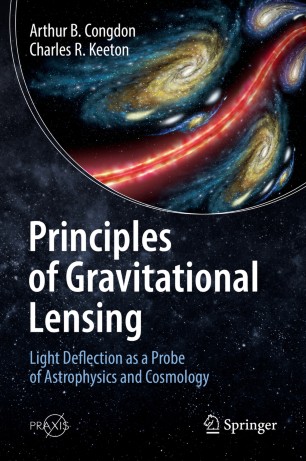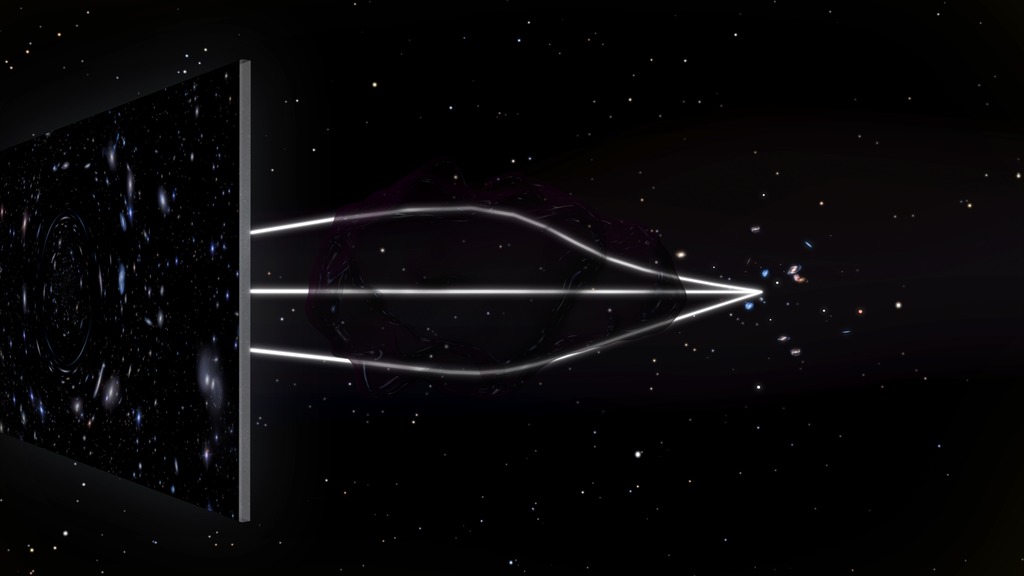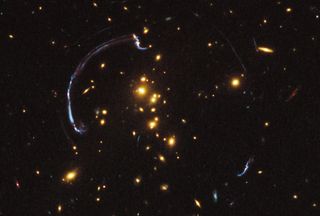Gravitational lensing images images are available. Gravitational lensing images are a topic that is being searched for and liked by netizens today. You can Download the Gravitational lensing images files here. Get all free vectors.
If you’re looking for gravitational lensing images images information connected with to the gravitational lensing images topic, you have pay a visit to the ideal site. Our site frequently gives you suggestions for viewing the highest quality video and picture content, please kindly surf and locate more informative video articles and images that match your interests.
In many of its views distant galaxies are smeared into arcs. Gravitational lensing x rays and other forms of light from distant objects such as this galaxy can be bent by the gravitational field of an intervening galaxy. Gravitational lensing is the natural phenomenon by which we see the magnified and multiple images of the distant objects galaxies stars quasar etc when the light emitted by these objects passes through the gravity of massive objects these massive objects distort the spacetime eg. The multiple image effect is produced by a process called gravitational lensing in which the gravitational field of a massive object bends and amplifies light from an object farther behind it. On a cosmic distance scale hubble space telescope regularly captures other images of gravitational lensing.
Gravitational Lensing Images. The multiple image effect is produced by a process called gravitational lensing in which the gravitational field of a massive object bends and amplifies light from an object farther behind it. This process is called gravitational lensing and in many cases can be described in analogy to the deflection of light by eg. Gravitational lensing x rays and other forms of light from distant objects such as this galaxy can be bent by the gravitational field of an intervening galaxy. This effect is known as gravitational microlensing.
 Gravitational Lensing Illustration Youtube From Simulation of a gravitational lens moving against a background field of galaxy. The gravity of the mass of the foreground object warps space. This bends the …
Gravitational Lensing Illustration Youtube From Simulation of a gravitational lens moving against a background field of galaxy. The gravity of the mass of the foreground object warps space. This bends the …
This effect is known as gravitational microlensing. Gravitational lensing is the natural phenomenon by which we see the magnified and multiple images of the distant objects galaxies stars quasar etc when the light emitted by these objects passes through the gravity of massive objects these massive objects distort the spacetime eg. Gravitational lensing x rays and other forms of light from distant objects such as this galaxy can be bent by the gravitational field of an intervening galaxy. This bending can produce multiple images of the same source. On a cosmic distance scale hubble space telescope regularly captures other images of gravitational lensing. The multiple image effect is produced by a process called gravitational lensing in which the gravitational field of a massive object bends and amplifies light from an object farther behind it.
Nasas hubble space telescope captured the first ever picture of a group of five star like images of a single distant quasar.
Glass lenses in optics. In many of its views distant galaxies are smeared into arcs. Gravitational lensing is the natural phenomenon by which we see the magnified and multiple images of the distant objects galaxies stars quasar etc when the light emitted by these objects passes through the gravity of massive objects these massive objects distort the spacetime eg. These images will in general be magnified by different amounts so can appear to have different brightnesses. Glass lenses in optics. This effect is known as gravitational microlensing.

This bending can produce multiple images of the same source. On a cosmic distance scale hubble space telescope regularly captures other images of gravitational lensing. In many of its views distant galaxies are smeared into arcs. Nasas hubble space telescope captured the first ever picture of a group of five star like images of a single distant quasar. In general relativity the presence of matter energy density can curve spacetime and the path of a light ray will be deflected as a result.
 Source: esa.int
Source: esa.int
The multiple image effect is produced by a process called gravitational lensing in which the gravitational field of a massive object bends and amplifies light from an object farther behind it. This bending can produce multiple images of the same source. Gravitational lensing x rays and other forms of light from distant objects such as this galaxy can be bent by the gravitational field of an intervening galaxy. This effect is known as gravitational microlensing. This process is called gravitational lensing and in many cases can be described in analogy to the deflection of light by eg.
 Source: spaceref.com
Source: spaceref.com
On a cosmic distance scale hubble space telescope regularly captures other images of gravitational lensing. On a cosmic distance scale hubble space telescope regularly captures other images of gravitational lensing. Gravitational lensing x rays and other forms of light from distant objects such as this galaxy can be bent by the gravitational field of an intervening galaxy. Glass lenses in optics. In general relativity the presence of matter energy density can curve spacetime and the path of a light ray will be deflected as a result.
 Source: EEAGOdrUU6WeCM
Source: EEAGOdrUU6WeCM
The multiple image effect is produced by a process called gravitational lensing in which the gravitational field of a massive object bends and amplifies light from an object farther behind it. This bending can produce multiple images of the same source. These images will in general be magnified by different amounts so can appear to have different brightnesses. Glass lenses in optics. Nasas hubble space telescope captured the first ever picture of a group of five star like images of a single distant quasar.

Gravitational lensing is the natural phenomenon by which we see the magnified and multiple images of the distant objects galaxies stars quasar etc when the light emitted by these objects passes through the gravity of massive objects these massive objects distort the spacetime eg. This bending can produce multiple images of the same source. In many of its views distant galaxies are smeared into arcs. Astronomers use those shapes to determine the distribution of mass in the galaxy clusters doing the lensing or to figure out their distribution of dark matter. The simplest type of gravitational lensing occurs when there is a single concentration of matter at the center such as the dense core of a galaxy.
 Source: ESA/Hubble, NASA, Suyu et al.
Source: ESA/Hubble, NASA, Suyu et al.
On a cosmic distance scale hubble space telescope regularly captures other images of gravitational lensing. The simplest type of gravitational lensing occurs when there is a single concentration of matter at the center such as the dense core of a galaxy. The multiple image effect is produced by a process called gravitational lensing in which the gravitational field of a massive object bends and amplifies light from an object farther behind it. This process is called gravitational lensing and in many cases can be described in analogy to the deflection of light by eg. Astronomers use those shapes to determine the distribution of mass in the galaxy clusters doing the lensing or to figure out their distribution of dark matter.

In general relativity the presence of matter energy density can curve spacetime and the path of a light ray will be deflected as a result. On a cosmic distance scale hubble space telescope regularly captures other images of gravitational lensing. In general relativity the presence of matter energy density can curve spacetime and the path of a light ray will be deflected as a result. Nasas hubble space telescope captured the first ever picture of a group of five star like images of a single distant quasar. This process is called gravitational lensing and in many cases can be described in analogy to the deflection of light by eg.
 Source: nGmKvfpH2-Q2dM
Source: nGmKvfpH2-Q2dM
The simplest type of gravitational lensing occurs when there is a single concentration of matter at the center such as the dense core of a galaxy. Astronomers use those shapes to determine the distribution of mass in the galaxy clusters doing the lensing or to figure out their distribution of dark matter. On a cosmic distance scale hubble space telescope regularly captures other images of gravitational lensing. In general relativity the presence of matter energy density can curve spacetime and the path of a light ray will be deflected as a result. This bending can produce multiple images of the same source.
 Source: svs.gsfc.nasa.gov
Source: svs.gsfc.nasa.gov
This bending can produce multiple images of the same source. In many of its views distant galaxies are smeared into arcs. In general relativity the presence of matter energy density can curve spacetime and the path of a light ray will be deflected as a result. This effect is known as gravitational microlensing. A gravitational lens is a distribution of matter such as a cluster of galaxies between a distant light source and an observer that is capable of bending the light from the source as the light travels towards the observerthis effect is known as gravitational lensing and the amount of bending is one of the predictions of albert einsteins general theory of relativity.
 Source: space.com
Source: space.com
On a cosmic distance scale hubble space telescope regularly captures other images of gravitational lensing. These images will in general be magnified by different amounts so can appear to have different brightnesses. This bending can produce multiple images of the same source. In general relativity the presence of matter energy density can curve spacetime and the path of a light ray will be deflected as a result. Nasas hubble space telescope captured the first ever picture of a group of five star like images of a single distant quasar.

Gravitational lensing is the natural phenomenon by which we see the magnified and multiple images of the distant objects galaxies stars quasar etc when the light emitted by these objects passes through the gravity of massive objects these massive objects distort the spacetime eg. Gravitational lensing x rays and other forms of light from distant objects such as this galaxy can be bent by the gravitational field of an intervening galaxy. The light of a distant galaxy is redirected around this core often producing multiple images of the background galaxy. This effect is known as gravitational microlensing. Astronomers use those shapes to determine the distribution of mass in the galaxy clusters doing the lensing or to figure out their distribution of dark matter.
This site is an open community for users to submit their favorite wallpapers on the internet, all images or pictures in this website are for personal wallpaper use only, it is stricly prohibited to use this wallpaper for commercial purposes, if you are the author and find this image is shared without your permission, please kindly raise a DMCA report to Us.
If you find this site adventageous, please support us by sharing this posts to your favorite social media accounts like Facebook, Instagram and so on or you can also bookmark this blog page with the title gravitational lensing images by using Ctrl + D for devices a laptop with a Windows operating system or Command + D for laptops with an Apple operating system. If you use a smartphone, you can also use the drawer menu of the browser you are using. Whether it’s a Windows, Mac, iOS or Android operating system, you will still be able to bookmark this website.





